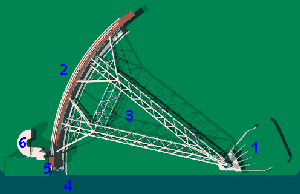



![[animation]](../../anigifs/104/sluit.gif)
The operation of the Storm Surge Barrier
Overall survey

In these circumstances the Storm Surge Barrier computer - the Command and Support System (Dutch acronym BOS) instructs the Control System (BES) to shut the barrier. The BES implements the BOS's commands.
Water is pumped into the parking dock. Once the retaining wall, starts to float and the water in the dock is at the same level as that in the New Waterway, the dock-gate is opened. The locomobiles positioned on top of the retaining wall push them horizontally out of the parking dock. The gates move into the New Waterway, approaching one another in the middle but not quite touching. Water is then admitted into the retaining walls. The construction sinks slowly onto the sill on the river-bottom, 17 metres below NAP.
Like a human shoulder-joint, the ball-joints - i.e. the pivotal bearings on both banks - are able to move in three directions. They need to do so in order to follow all the gates' movements, both horizontally (when the gates are floated out) and vertically (upon submersion). In addition the gates must be able to ride up and down with the waves when being closed and opened. The forces on the gates are transmitted through the trusses and the pivot to the foundation of the ball-joint, a colossal triangular concrete block.
Once the storm is over the water is pumped out of the retaining walls, which begin to float again. The retaining walls are driven back into the dock, by the locomobiles. The dock-gates are closed, and the dock is pumped dry.